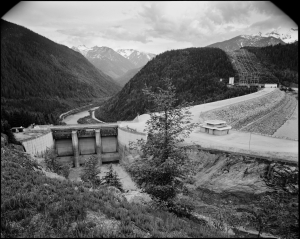April 09, 2022 through May 11, 2022
Robbie McClaran - The Great River of the West
The river we know today as ‘Columbia’ was known for thirteen millennia by the names given by its original inhabitants:
Wihmal, Nch’i-Wàna, and Shwan-etk-qwa among others.
Big River or Great River.
Captain Robert Gray christened it ‘Columbia,’ after his ship the Columbia Rediviva. ‘Columbia’ is from Christopher Columbus, a man who raped, murdered, enslaved and spread disease to indigenous people and destroyed their cultures.
Gray, credited as the first white man to navigate ‘Big River’s’ treacherous bar and sail upstream, was a merchant seaman in search of furs, who murdered native people who wouldn’t comply with his demands.
The name ‘Columbia’ carries this weight.
In 1867, when Carleton Watkins began his photographic expedition up the Columbia River Gorge, the river looked much as it had for the previous 13,000 years of indigenous human habitation. Yet even then, railways had already been laid to facilitate the movement of white settlers past rapids and falls that made navigating the river extremely dangerous. That influx of settlers set in motion events that would change the Columbia, the fates of the native people, and the Pacific Northwest forever.
Today the River is fully industrialized, its once wild rapids pooled behind 14 dams into a series of vast lakes. While dams provide water for irrigation, hydropower and slack water for navigation, it comes at a terrible price. The extraordinarily abundant Salmon runs have dwindled to near extinction. Indigenous people have been mostly displaced from their ancestral homelands, and their traditional fishing grounds inundated by dams. The river still flows through a majestic and diverse landscape, yet it’s rare to find a view that does not include stark evidence of the impact of the European immigrants who displaced them.
“The Great River of the West’‘ is a photographic survey of the 1250 mile long Columbia River, from its source in the Canadian Rockies, to the confluence with the Pacific, exploring its current cultural and economic landscape, with an eye towards its significance in the history of the Pacific Northwest and North America. This selection of the resulting photographs is displayed geographically, with the first image at the source and the last at the confluence.
This project has been generously supported by grants from the Oregon Arts Commission, the Ford Family Foundation and the Regional Arts and Culture Council (RACC).
Robbie McClaran
Beginning in 2013, and working with an antique eight-by-ten, large format camera, Robbie McClaran has been photographing along the entire 1250-mile length of the Columbia River, from its source in British Columbia to its confluence with the Pacific Ocean. “The Great River of the West”, explores the River’s current cultural and economic landscape as well as environmental alterations. The photographs serve as an 21st century archive of the landscape and communities along the River, with an eye towards its significance in the history of the Pacific Northwest and North America.
Robbie McClaran is a documentary and fine art photographer whose work focuses on the American people and landscape. His work has been widely exhibited and published, appearing in numerous magazines throughout the world. Robbie’s work is held in several private and public collections including The Smithsonian National Portrait Gallery, Portland Art Museum, University of Oregon, and New Orleans Museum of Art.

